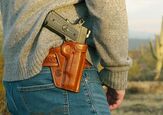Beretta LTLX7000 shotgun

Future Weapons recently demonstrated a fascinating prototype less-lethal shotgun from Beretta. What is interesting is that the kinetic energy expended on the target from the rubber bullet is constant regardless of the range. This fixes a common problem with less-lethal ammunition: they are often powerful enough to kill at close range and to weak at long range to stop the target.
View though the LTLX7000 scope.
The range is configured using the holographic scope. The distance is set by moving two red dots in the scope until the bottom dot is at the feet of the target and the top dot it at the top of the head of the target. Because the approximate height of people in the region will be programmed into the scope, it can easily calculate the distance to the target. This method of calculating distance is similar to how hunters and snipers calculate range using mil-dot scopes.
The round is then fired by pulling a trigger. In the video we see a round hitting a target placed at 50 and 230 feet away at the same speed ( 309 fps).
The video:
The only way I think this could work is by venting gas from the barrel. The amount of gas vented would depend on the range selected. The more gas vented, the lower the gas pressure behind the projectile, and so the speed is reduced. The slower the projectile, the lower the kinetic energy expended on the target.
When watching the video you can see a puff of smoke coming out of the action after each shot is fired. This is not a semi-automatic firearm so it cannot be coming from the action cycling automatically. It must be coming from a vent.
I did some patent searching and I managed to find a patent entitled “ Variable velocity weapon system having selective lethality and methods” that describes almost this exact system:
The present invention relates to weapon systems that accelerate projectiles using gases generated by the rapid combustion of a solid propellant, in particular, such a weapon system is able to vary the barrel exiting velocity of the projectile through a barrel venting means. In one embodiment, a front venting means exhausts gas generated by combusting propellant from behind the accelerating projectile and redirects a portion of the exhausted gas either to at least one fixed volume, to the front of the projectile, or to a combination of at least one fixed volume and to the front of the projectile. Redirecting some of the exhausted gas to the front of the projectile restrains the projectile, thereby slowing the projectile, and thus further decreasing the muzzle velocity of the projectile. In another embodiment, gas from behind the projectile is exhausted into a fixed volume, thereby decreasing projectile acceleration, and thus, the muzzle velocity of the projectile. One can use a…
Venting system proposed by patent.
The patent suggests venting gas in front of the projectile in the barrel to increase the air pressure and slow it down.

I founded TFB in 2007 and over 10 years worked tirelessly, with the help of my team, to build it up into the largest gun blog online. I retired as Editor in Chief in 2017. During my decade at TFB I was fortunate to work with the most amazing talented writers and genuinely good people!
More by Steve Johnson












![[NRAAM 2024] Warbird American Made Level IIIA Soft Body Armor](https://cdn-fastly.thefirearmblog.com/media/2024/06/04/0643118/nraam-2024-warbird-american-made-level-iiia-soft-body-armor.jpg?size=350x220)






![[SHOT 2024] META Tactical Taurus G3 Apex Carbine Conversion](https://cdn-fastly.thefirearmblog.com/media/2024/05/16/14529055/shot-2024-meta-tactical-taurus-g3-apex-carbine-conversion.jpg?size=350x220)

![[NRAAM 2024] The NEW Anderson Frontline Series AR15s](https://cdn-fastly.thefirearmblog.com/media/2024/06/04/0643117/nraam-2024-the-new-anderson-frontline-series-ar15s.jpg?size=350x220)

Comments
Join the conversation
What i think is it would be very hard to get the targets height if he/she is moving
The Army has asked for a variable power non-lethal that works from 5-400 meters. This looks great for shorter range...but they also asked that the launcher not be able to shoot lethal rounds or look like it can to prevent escalation. Like to see an article about that...
Also check out the EOTech Sage sight, it is WAAAAY faster than moving anything anywhere. Wedge the guy into the curves and pull the trigger. Beretta owns Benelli and Burris with their Eliminator Laser Scope, but there seems to be a mechanical adjustment to the weapon that still has to be done which the optical ranging process does. Excellent package!